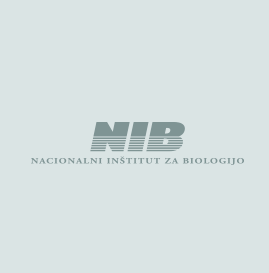Projects
Biotechnological Hub of the NIB (BTH-NIB)
The purpose of the investment project BTH-NIB is the assurance of the appropriate infrastructural conditions for the use of research and developmental opportunities in the fields of operation of the NIB.
Play Video About project Publication
Bilateral cooperation Slovenia - Serbia: Freshwater invertebrates as bioindicators of exposure to cytostatics residues
Project coordinator: prof. dr. Metka Filipič
Coordinator for NIB: Faculty of Biology, University of Belgrade
Code: ARRS-BI-RS/14-15-013
Duration: 1.11.2014 - 31.12.2015
The occurrence of pharmaceuticals in the environment may be the consequence of their insufficient removal during wastewater treatment, stability towards photolysis, slow degradation, etc. Knowing that lower organisms in aquatic ecosystems have receptors and pathways similar to humans, pharmaceuticals, especially cytostatics, may affect their growth and reproduction, including a range of physiological, histological and molecular responses, alterations of antioxidative status, induction of DNA damage, etc. The biological consequences of DNA damage can be initiated at the cellular, organ, and whole animal and community and population levels.
Freshwater mussels are commonly employed in the ecogenotoxicological studies. They have several characteristics, such as wide distribution, filter feeding, a sessile life form and an ability to accumulate pollutants, which makes them favorable organisms for estimating the environmental pollution level and the bioavailability of various types of pollutants. In response to environmental stress they show a range of physiological, histological and molecular responses, including abnormal morphology, alterations of antioxidative status, induction of DNA damage, etc. Previous studies in Serbia (Kolarević et al. 2013; Vuković-Gačić et al. 2013) have shown high sensitivity of freshwater mussels Unio pictorum and Unio tumidus for the detection of genotoxic pollution in the environment. Freshwater oligochaete Limnodrilus udekemianus is a cosmopolitan tubificid species often found in organic-rich sediment. Many of freshwater oligochaetes with their benthic, sediment borrowing way of life and low mobility directly interact in the recycling of materials in water and sediment, in a food chain structure, and therefore they are especially affected by the presence of xenobiotics in aquatic environment.
In the proposed project we will explore toxic and genotoxic effect of the residues of different cytostatics as well as their mixtures and mixtures with other common pollutants (i.e. heavy metals) at concentrations relevant for environmental pollution in freshwater mussels and in Limnodrilus udekemianus. The genotoxic effects will be compared the effects obtained in zebrafish liver cell line (ZFL), which is an established in vitro model for aquatic toxicity. Genotoxicity will be determined with the comet and micronucleus assays, two biomarkers reflecting different forms of genetic damage that are widely used to detect genotoxic effects of pollution-related environmental stress. The comet assay detects single and double DNA strand breaks that are formed directly or as the intermediates during the DNA repair. Micronucleus assay detects structural and numerical chromosomal aberrations formed mainly after cell division as a consequence of DNA double-strand breakage or dysfunction of proteins involved in chromosome segregation. The obtained results will contribute to better understanding of the fate and biological effects of the residues of cytostatics in the environment to non-target aquatic organisms and contribute to improved environmental risk assessment. The proposed project would be a complement of the on-going FP7-ENV project Cyto Threat (2011-2014). The two groups have complementary expertise and a long standing history of successful collaboration. The Chair of microbiology, Faculty of Biology, University of Belgrade has the expertise in the alkaline comet assay on haemocytes and gill cells of mussels and on mixture of haemocytes and coelomocytes of Limnodrilus udekemianus. The Department for Genetic Toxicology and Cancer Biology, National Institute of Biology in Ljubljana, has long experience in in vitro experimental systems including analysis of genetic damage by recently developed version of the micronucleus assay, the cytome assay that enables evaluation of the formation of multiple types of damage (micronuclei (MNi), nuclear bud (NBUD), nucleoplasmic bridge (NPB) formation.


 Scope of NIB's accreditation is given in the Annex to the accreditation certificate and in the List of accredited methods for detection of GMOs and microorganisms – plant pathogens
Scope of NIB's accreditation is given in the Annex to the accreditation certificate and in the List of accredited methods for detection of GMOs and microorganisms – plant pathogens Holder of National Standard in the Field of Amount of Substance/Bioanalysis of Nucleic Acids/GMOs and Microorganisms
© 2023- National institute of biology, all rights reserved

